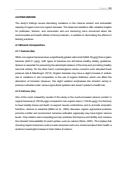P a g e | 31 4.0 DISCUSSION The study's findings reveal interesting variations in the mineral content and antioxidant capacity of organic and non-organic bananas. The observed variations offer valuable insights for politicians, farmers, and consumers who are becoming more concerned about the environmental and health effects of food production, in addition to illuminating the effects of farming practices. 4.1 Mineral Composition 4.1.1 Sodium (Na) While non-organic bananas have a significantly greater salt content (684.78 µg/g) than organic bananas (643.51 µg/g), both types of bananas are still below healthy dietary guidelines. Sodium is essential for preserving the electrolyte balance of the body and promoting healthy neuronal activity. On the other hand, overindulgence carries concerns such elevated blood pressure (He & MacGregor, 2013). Organic bananas may have a slight increase in sodium due to variations in soil composition or the use of organic fertilisers, which can affect the absorption of minerals. However, this slight variation emphasises the inherent variety in produce cultivated under various agricultural systems and doesn't present a health risk. 4.1.2 Calcium (Ca) One of the most noteworthy results of this study is the much-increased calcium content in organic bananas (2,129.46 µg/g) compared to non-organic ones (1,744.45 µg/g). For the body to have healthy bones and teeth, to support muscle contractions, and to promote enzymatic functions, calcium is essential (Milton et al., 2023). Because organic agricultural practices promote a better soil environment, bananas cultivated organically may have higher calcium levels. Crop rotation and composting are two practices that improve soil fertility and increase the minerals' bioavailability for plant uptake, such as calcium (Wien, 2007). This implies that choosing organic bananas could provide consumers who are concerned about their health a small but meaningful increase in their intake of calcium.
